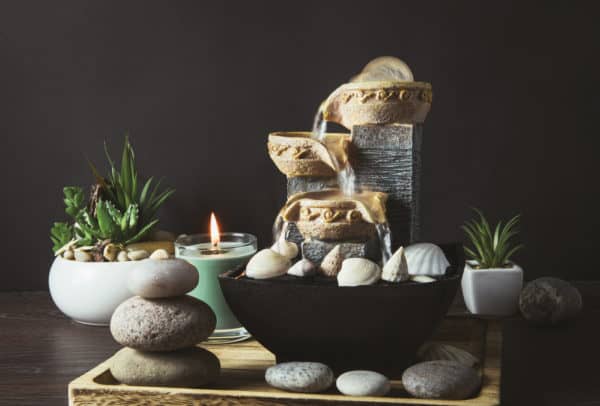The winter weather has begun to dry out the air in your home, causing your skin to crack and your lips to bleed. You want to raise the humidity in your home, but also want something more attractive than a bulky humidifier.
Indoor water fountains often increase the humidity of a room similar to a humidifier. Added humidity in a room can be beneficial for personal health and plant life, but too much humidity can cause unwanted problems such as an increase in mold and mildew growth.
It’s common knowledge that increasing humidity in the home can be beneficial to keeping your skin healthy, but that’s not the only thing added humidity can be good for. Additional humidity can be beneficial to not only your health but to the health of your house plants, as well as your furniture.
Personal Health Benefits
Adding humidity to the air is good for your skin, and it can also help guard against bloody noses and dry coughs. A good humidity level for a room is between 30% and 50%. You may become more susceptible to congestion and headaches when the air is too dry, so adding moisture to the air can help prevent that as well.
Proper humidity levels in the air can also help prevent against catching the flu! The additional moisture causing the virus to be deactivated more quickly and less likely to spread.
If you tend to snore at night, adding a humidifier may help you increase your ability to breathe at night and potentially snore less. When there is not enough moisture in the air, your airways are not lubricated well, which can cause you to snore more.
Fountains for Humidity
While you will get some natural humidity simply by having water in the room, having a waterfall style water feature where the water has the travel and splash will help disperse the water into the air more quickly.
It doesn’t have to be large, but purchase a fountain that cycles the water, and has one or two waterfall features built into it for the best effect and maximum humidity.
Benefits to the Home
When the air is too dry, not only do you feel it but so do your wooden floors and furniture. When there is not enough humidity in the air, wood will age faster by shrinking, warping, and cracking. By maintaining proper humidity levels in your home you will also add extra life to your floors and furniture.
If you are finding that your favorite wooden rocking chair is already beginning to dry out, you can rejuvinate your furniture by rubbing it down with a soft cloth and some furniture oil or paste wax. If using the wax, after five minutes, buff the area with a cloth in the direction of the grain of the wood to remove excess wax.
Additional humidity in the air also helps the air feel warmer at lower temperatures, which may help you save on heating bills in the winter. It can also cause there to be less static in the air preventing static electricity shocks, and helping protect electrical devices.
Benefits for Your Plants
Houseplants also need humidity to thrive. While you still need to water them, your plants will thank you if the humidity is kept up. Cacti and other desert plants prefer at least 40% humidity, whereas other plants like 50% to 60%.
When humidity levels are too low, plants are more likely to dry out or get diseased. When your plants are healthier, they are better equipped to pull toxins out of the air, improving the air quality of your home.
If your plants are tropical, there’s a good chance the added humidity will benefit them. Signs your plants are too dry may include a shriveled base, yellowing, wrinkled leaves, or less new growth than normal.
Too Much Humidity
While adding humidity to a room can be a good thing, there is such a thing as too much humidity. If your home is starting to feel stuffy, it may be because there is too much humidity inside.
Humidity levels that are too high can be detrimental to the health of your plants. High humidity levels can prevent plants from allowing water to evaporate, and after an extended time can lead them to rot and die. Too much humidity can also make them more susceptible to disease, root rot, and pest like gnats that are incredibly hard to get rid of.
To keep track of the humidity in the air, you can purchase a hygrometer, an instrument used to measure the humidity of the air and that looks like a thermometer. You can find and purchase hygrometers online or at local hardware stores.
If your humidity is too high, you may want to invest in a dehumidifier to prevent against mold and mildew. In the summer months, using the air conditioner may also help lower the humidity.
When there is too much moisture in the air, condensation can build up on the walls and floors, allowing for bacteria, mildew, and mold to grow. This can be especially dangerous for someone who has asthma or other respiratory problems.
If you find that mold and mildew are growing in your home, you can treat it to get rid of it with a solution of bleach and water. Mix one part bleach to three parts water together but be sure not to use bleach on any surface that will get damaged by the bleach. Apply to the affected areas with a damp sponge, and when finished, dry with an old rag or towel.
If the mold or mildew is in the carpets, you’ll want to get them professionally cleaned. Unless you have carpet cleaning experience, cleaning them yourself can damage your flooring, and there’s a good chance you’ll miss some of the mold. Professionals will make sure the mold or mildew is completely gone, with a very thorough clean.

